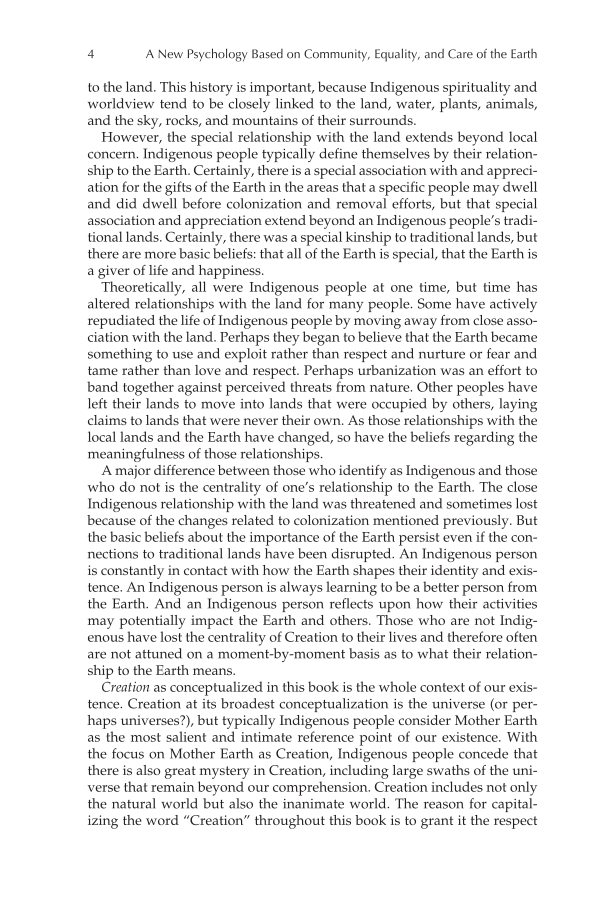4 A New Psychology Based on Community, Equality, and Care of the Earth to the land. This history is important, because Indigenous spirituality and worldview tend to be closely linked to the land, water, plants, animals, and the sky, rocks, and mountains of their surrounds. However, the special relationship with the land extends beyond local concern. Indigenous people typically define themselves by their relation- ship to the Earth. Certainly, there is a special association with and appreci- ation for the gifts of the Earth in the areas that a specific people may dwell and did dwell before colonization and removal efforts, but that special association and appreciation extend beyond an Indigenous people’s tradi- tional lands. Certainly, there was a special kinship to traditional lands, but there are more basic beliefs: that all of the Earth is special, that the Earth is a giver of life and happiness. Theoretically, all were Indigenous people at one time, but time has altered relationships with the land for many people. Some have actively repudiated the life of Indigenous people by moving away from close asso- ciation with the land. Perhaps they began to believe that the Earth became something to use and exploit rather than respect and nurture or fear and tame rather than love and respect. Perhaps urbanization was an effort to band together against perceived threats from nature. Other peoples have left their lands to move into lands that were occupied by others, laying claims to lands that were never their own. As those relationships with the local lands and the Earth have changed, so have the beliefs regarding the meaningfulness of those relationships. A major difference between those who identify as Indigenous and those who do not is the centrality of one’s relationship to the Earth. The close Indigenous relationship with the land was threatened and sometimes lost because of the changes related to colonization mentioned previously. But the basic beliefs about the importance of the Earth persist even if the con- nections to traditional lands have been disrupted. An Indigenous person is constantly in contact with how the Earth shapes their identity and exis- tence. An Indigenous person is always learning to be a better person from the Earth. And an Indigenous person reflects upon how their activities may potentially impact the Earth and others. Those who are not Indig- enous have lost the centrality of Creation to their lives and therefore often are not attuned on a moment-by-moment basis as to what their relation- ship to the Earth means. Creation as conceptualized in this book is the whole context of our exis- tence. Creation at its broadest conceptualization is the universe (or per- haps universes?), but typically Indigenous people consider Mother Earth as the most salient and intimate reference point of our existence. With the focus on Mother Earth as Creation, Indigenous people concede that there is also great mystery in Creation, including large swaths of the uni- verse that remain beyond our comprehension. Creation includes not only the natural world but also the inanimate world. The reason for capital- izing the word “Creation” throughout this book is to grant it the respect
Document Details My Account Print multiple pages
Print
You have printed 0 times in the last 24 hours.
Your print count will reset on at .
You may print 0 more time(s) before then.
You may print a maximum of 0 pages at a time.




















































































































































































































































































